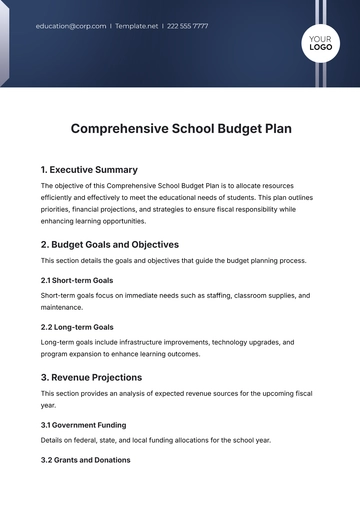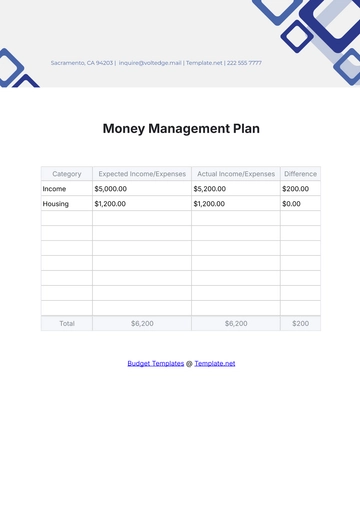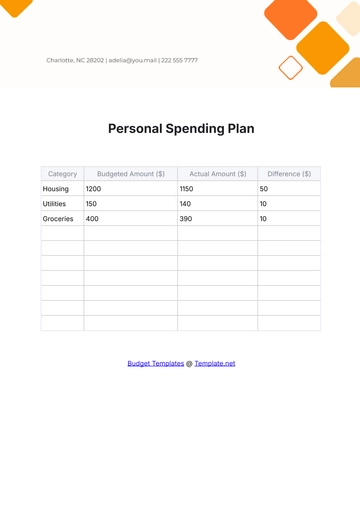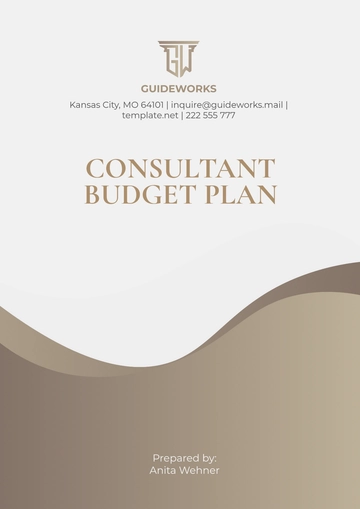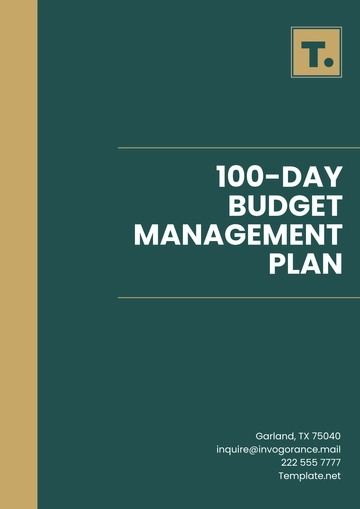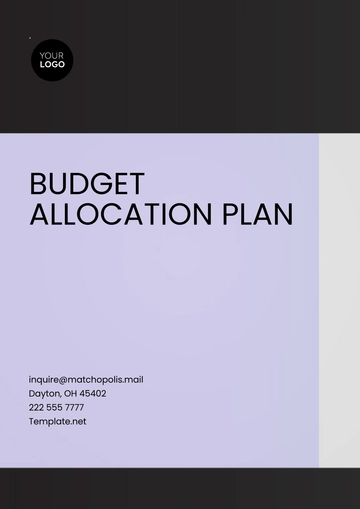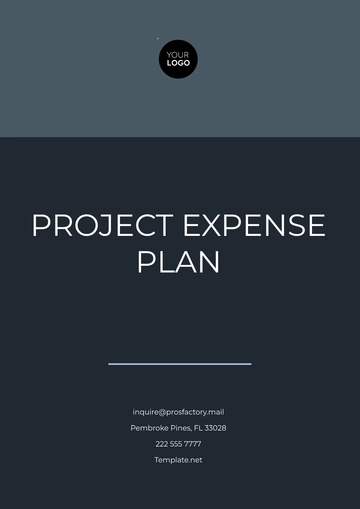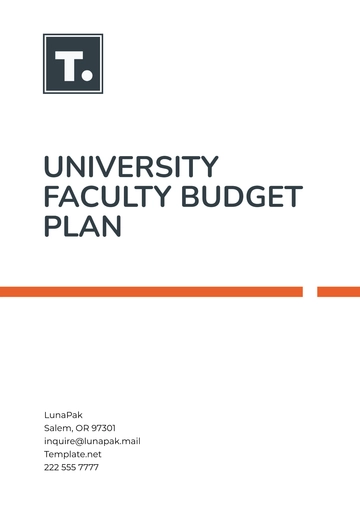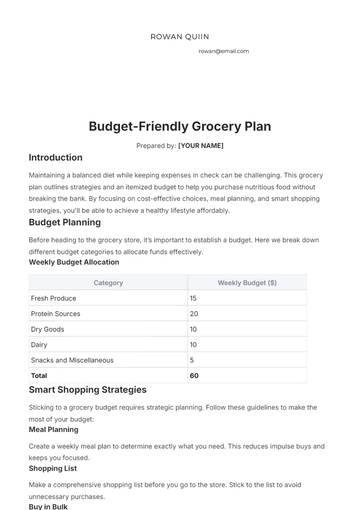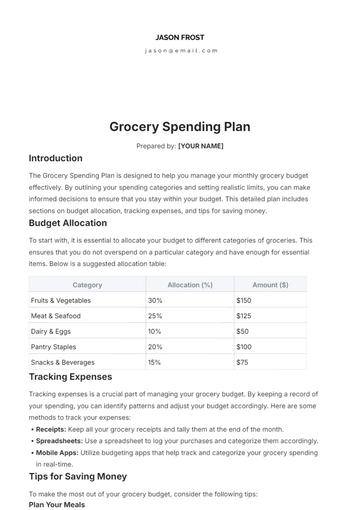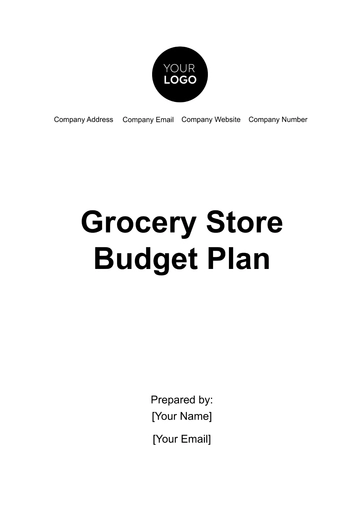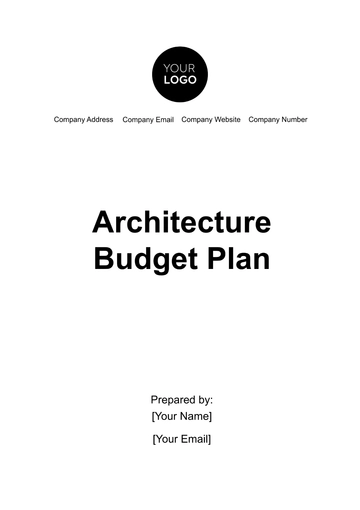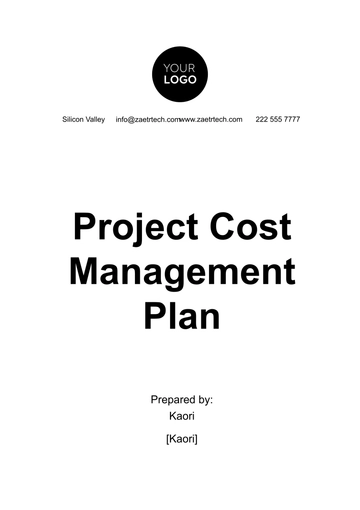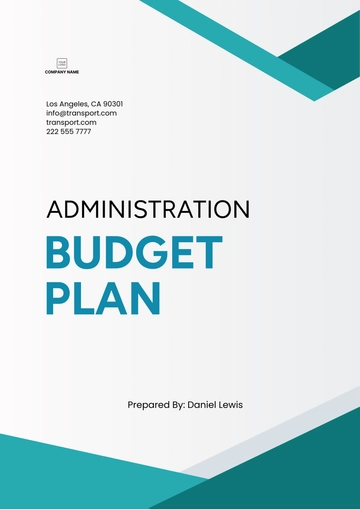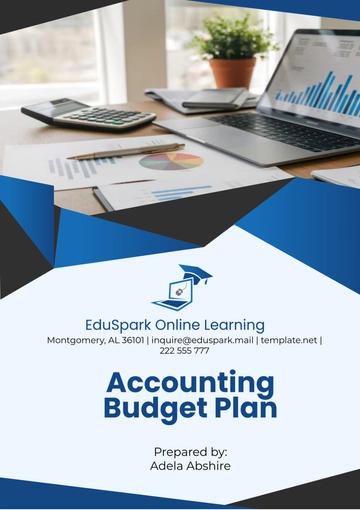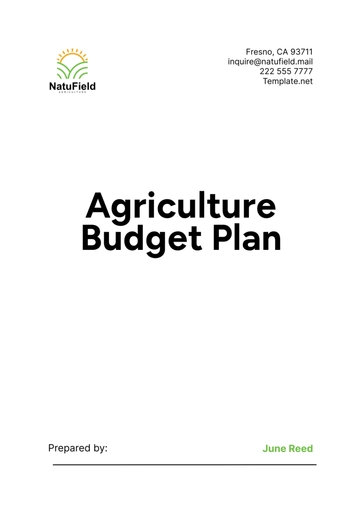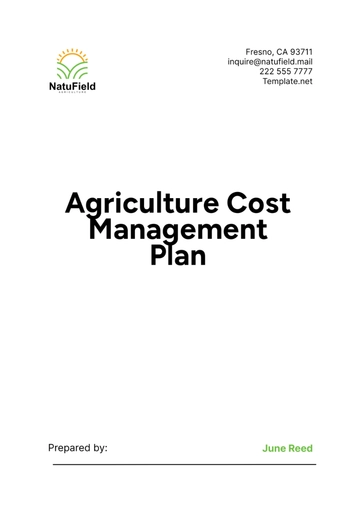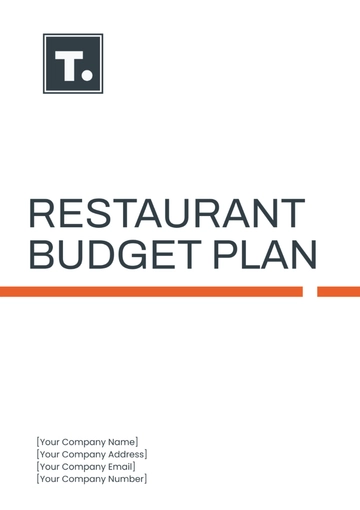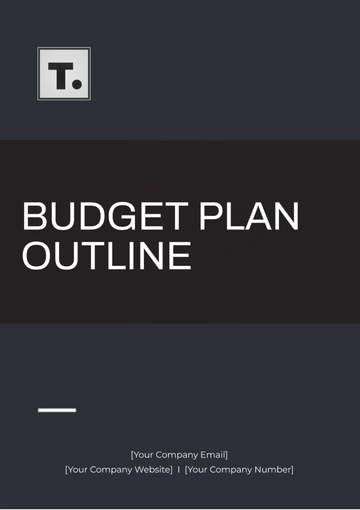Free Finance Multi-Year Budget Plan
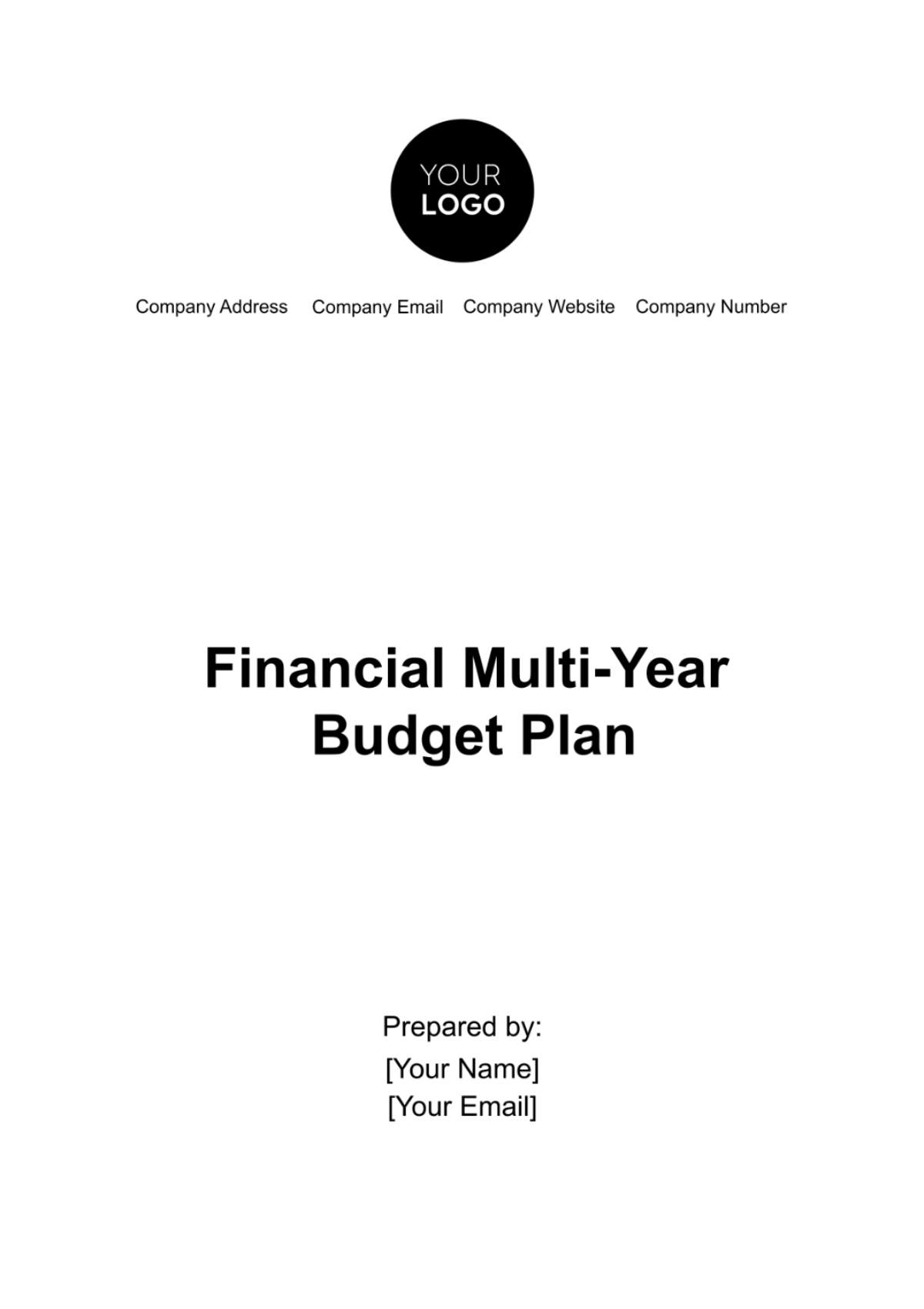
Executive Summary |
This Multi-Year Budget Plan serves as a strategic roadmap for our financial planning and management over the next five years. It is designed to align our financial resources with our long-term organizational goals, ensuring sustainable growth and financial stability. This plan outlines our approach to revenue generation, expenditure control, capital investment, and risk management from [2084 to 2088]. It provides a comprehensive framework for decision-making, prioritizing investments, and guiding our financial practices in a manner that supports our overarching strategic objectives.
Key Highlights of the Budget Plan
A target of 5% annual revenue growth, reaching $50 million by 2088.
Planned capital investments totaling $15 million, focusing on technology upgrades and facility expansion.
Implementation of cost-saving measures aimed at reducing operational expenses by 10% over the next five years.
A plan to reduce our existing debt by 25% by 2088 through structured repayment and refinancing options.
Summary for the Multi-Year Period
A. Revenue Diversification and Growth: Expanding our revenue base by introducing new products and services, and entering new markets, contributing to a steady growth in annual revenue.
B. Operational Efficiency: Enhancing operational efficiency through process improvements and technology adoption, aiming to lower operational costs while maintaining high service quality.
C. Capital Expenditure and Infrastructure Development: Strategically investing in our infrastructure and technology to support growth, improve customer experience, and increase operational efficiency.
D. Financial Stability and Debt Management: Strengthening our financial stability by maintaining healthy cash flow levels and reducing long-term liabilities.
E. Risk Mitigation: Proactively identifying and mitigating financial risks, including market fluctuations, regulatory changes, and economic uncertainties, through robust contingency planning.
Strategic Financial Objectives |
A. Sustainable Revenue Growth: Aim to achieve a consistent 5% annual growth in revenue over the next five years, culminating in a total revenue increase of 25% by 2088. This growth will be fueled by expanding our product line, entering new markets, and enhancing sales strategies.
B. Cost Efficiency and Profitability: Target a 10% reduction in operational costs by 2086 through process optimization and technological advancements, thereby improving our overall profitability margins.
C. Debt Reduction and Improved Financial Leverage: Plan to reduce existing debt by 25% within the five-year timeframe. This will be achieved through strategic refinancing options and allocating a portion of annual profits to debt repayment.
D. Capital Investment and Asset Management: Allocate $15 million towards capital investments over the next five years, focusing on technology upgrades and infrastructure expansion to foster long-term growth and asset value enhancement.
E. Risk Management and Financial Resilience: Establish a robust financial risk management framework to proactively identify and mitigate potential financial risks, ensuring the resilience of our financial position in face of market volatilities and economic changes.
Alignment with Overall Organizational Strategy
Our goal of sustainable revenue growth is directly aligned with our strategic objective to expand into new markets and diversify our product offerings. This expansion strategy is designed to broaden our customer base and reduce dependency on our existing markets.
The focus on cost efficiency and operational optimization aligns with our broader strategy to embrace technological innovation. By investing in advanced technologies, we aim to streamline operations, reduce costs, and improve customer experiences.
Our debt reduction and capital investment goals reflect a strategic balance between pursuing growth opportunities and maintaining financial health. By managing our debt levels and investing wisely in assets, we ensure long-term sustainability and shareholder value.
Aligning our risk management objectives with our overall strategy ensures that we can pursue our growth ambitions while being prepared for potential financial uncertainties. This approach supports our strategic goal of building a resilient and adaptable organization.
Revenue Projections |
This section of our Multi-Year Budget Plan provides a detailed forecast of our expected revenue streams over the next five years. These projections are based on a thorough analysis of market trends, historical data, and strategic initiatives, forming a critical foundation for our financial planning and decision-making.
The following table outlines our projected revenue streams from [2084 to 2088]:
Year | Projected Revenue ($) | Year-over-Year Growth |
2084 | 42,000,000 | 5% |
2085 | ||
2086 | ||
2087 | ||
2088 |
Analysis of Trends, Market Conditions, and Assumptions
A significant portion of our revenue growth is anticipated to come from expanding into new markets, particularly in emerging economies. By [2086], we expect new market operations to contribute approximately [15%] to our total revenue.
Continuous investment in research and development is projected to yield new products, contributing to a [10%] increase in revenue from our existing product lines by [2087].
Efforts to broaden our customer base, including enhanced digital marketing strategies and customer engagement initiatives, are expected to increase revenue by 8% annually.
A moderate annual price increase in line with inflation and market standards is factored into the revenue projections, assuming a standard inflation rate of [2-3%] per annum.
The projections assume a stable economic environment, with no significant disruptions in the global economy. A contingency plan is in place to adjust the projections in case of economic downturns.
These projections take into account the current competitive environment in our industry. They assume that our market share will remain stable, with proactive strategies in place to counteract any aggressive moves by competitors.
Expenditure Projections |
In this section, we present a detailed breakdown of our anticipated expenditures over the next five years. This projection is essential for effective financial planning, enabling us to align our spending with strategic priorities and financial goals.
The following chart categorizes our expected expenses into operational, capital, and other expenditures from [2084 to 2088]:
Analysis of Expenditure Trends and Factors
A. Cost Control Measures: Our financial strategy includes rigorous cost control measures to ensure efficiency in operational spending. Investments in automation and process optimization are expected to yield long-term savings in operational expenses.
B. Strategic Spending: Capital expenditures are aligned with our strategic initiatives, particularly in technology and infrastructure, to support sustainable growth.These investments are critical for maintaining competitive advantage and ensuring operational efficiency.
C. External Factors: We are closely monitoring external factors such as market trends, supply chain dynamics, and regulatory changes, which may impact future costs. Our budget includes a contingency reserve to address unforeseen expenses resulting from these external factors.
Cash Flow Projections |
This section presents a comprehensive forecast of our cash inflows and outflows over the next five years. These projections are crucial for ensuring that we maintain sufficient liquidity for operational sustainability and strategic investments.
The following table provides an overview of our projected cash flow from 2084 to 2088:
Year | Cash Inflows | Cash Outflows | Net Cash Flow | Cumulative |
2084 | 42,000,000 | 35,000,000 | 7,000,000 | 7,000,000 |
2085 | ||||
2086 | ||||
2087 | ||||
2088 |
Analysis of Cash Flow Implications
A. Operational Liquidity: The projected net cash flows indicate a positive trend, ensuring we have sufficient liquidity to meet our operational needs. This is critical for maintaining smooth day-to-day operations and meeting short-term financial obligations.
B. Investment Capacity: The cumulative net cash flow provides us with the financial capacity to pursue strategic investments, particularly in capital projects as outlined in our expenditure projections. This aligns with our long-term growth objectives.
C. Debt Management: The positive cash flow positions us favorably for managing existing debt and potentially reducing reliance on external financing. This is in line with our strategy to reduce overall debt levels.
D. Risk Mitigation: We maintain a reserve within our cash flow to address unforeseen events or market fluctuations, ensuring financial resilience. This reserve is an integral part of our risk management strategy.
E. Sustainability and Growth Funding: Our healthy cash flow enables us to allocate funds towards sustainability initiatives and innovation, supporting our commitment to corporate social responsibility and long-term value creation.
Capital Budget and Investment Plan |
This section outlines our detailed plan for capital expenditures over the next five years, focusing on significant investments in infrastructure, technology, and major projects. It also describes our strategy for financing these critical investments, ensuring they align with our long-term financial goals and operational needs.
The following chart provides a breakdown of our planned capital expenditures from 2084 to 2088:
Strategy for Financing Capital Investments
A. Internal Cash Reserves: A significant portion of our capital investments will be financed through internal cash reserves accumulated from our operational profits. This approach aligns with our goal of utilizing existing financial resources efficiently and reducing dependency on external funding.
B. Long-Term Debt Financing: For larger projects, especially in infrastructure, we plan to leverage long-term debt financing. This will allow us to spread the cost of substantial investments over time, matching the benefits of the investment with its financing.
C. Grants and Subsidies: We will actively seek out grants and subsidies, particularly for projects that contribute to environmental sustainability or technological innovation. This can provide a source of funding without diluting equity or increasing debt.
D. Reinvestment of Depreciation: Funds accumulated through depreciation will be reinvested into capital projects, particularly for technology upgrades and replacing aging assets.
Risk Assessment and Contingency Planning |
In this section, we delve into the analysis of potential financial risks that may impact our organization over the next five years, including market volatility, interest rate fluctuations, and economic downturns. We also outline our contingency plans to address these significant financial risks, ensuring preparedness and resilience.
The table below presents our analysis of key financial risks and the corresponding contingency plans:
Financial Risk | Analysis | Contingency Plan |
Market Volatility | Exposure to market fluctuations impacting investment returns and operational costs. | Diversifying investment portfolio and hedging strategies to mitigate losses. |
Interest Rate Changes | Risk of increased borrowing costs due to rising interest rates. | Locking in fixed-rate loans where feasible and maintaining a balanced debt structure. |
Economic Downturns | Potential decrease in demand and revenue in a sluggish economy. | Building a reserve fund and focusing on cost-efficient operations to weather downturns. |
Currency Fluctuations | Exposure to foreign exchange risks due to international operations. | Using currency forward contracts and maintaining a currency reserve for key transactions. |
Regulatory Changes | Potential impact from new laws or changes in existing regulations. | Staying informed through regulatory monitoring and flexible adaptation in business practices. |
Technology Disruptions | Risks associated with cyber threats and technological obsolescence. | Investing in cybersecurity measures and regularly updating technology infrastructure. |
Performance Metrics and Targets |
In this section, we outline the key performance indicators (KPIs) that will be used to measure our financial health and monitor our progress towards achieving the objectives set out in this multi-year plan. Establishing clear targets for each KPI enables us to track performance effectively and make informed decisions.
The table below details our selected KPIs along with their respective targets for the multi-year period:
KPI | 2084 | 2085 | 2086 | 2087 | 2088 |
Annual Revenue Growth | 5% | ||||
Operational Cost Reduction | 2% | ||||
Debt-to-Equity Ratio | 0.8 | ||||
Return on Investment (ROI) | 8% | ||||
Net Profit Margin | 12% | ||||
Customer Satisfaction Index | 85% | ||||
Employee Retention Rate | 90% | ||||
Capital Expenditure Efficiency | 95% |
Assumptions and Sensitivity Analysis |
This section details the key assumptions underlying our financial projections and conducts a sensitivity analysis to understand the impact of potential changes in these assumptions. This analysis is crucial for assessing the robustness of our financial plan against various economic scenarios.
Our financial projections are based on several critical assumptions:
Economic Growth: An average annual GDP growth rate of 2.5%.
Inflation Rate: A steady annual inflation rate of 2%.
Market Conditions: Stable market conditions with average industry growth of 3% per year.
Interest Rates: Interest rates are assumed to remain at current levels, with a potential increase of up to 1% over the next five years.
Exchange Rates: Exchange rates are expected to remain relatively stable, with minor fluctuations of up to 2%.
Regulatory Environment: No significant changes in the regulatory landscape that could impact operations.
Sensitivity Analysis
Assumption | Change | Impact | ||
Revenue | Net Profit | Capital Expenditures | ||
Economic Growth | -1% | - 5% | -7% | Reevaluate major projects |
Inflation Rate | +4% | +3% | -4% | Increase in costs by 5% |
Market Conditions | Slowdown | -6% | -8% | Postpone non-essential investments |
Interest Rates | + 1% | Minor impact | -2% | Increase in financing costs |
Debt Management and Financing Strategies |
This section provides an overview of our current debt position and outlines our plans for future borrowing. Additionally, it details our strategic approach to managing these debt obligations and addressing our financing needs sustainably.
The following table summarizes our existing debt and outlines our plans for future borrowing over the next five years:
Year | Existing Debt | New Borrowing | Debt Repayment | Net Debt Position |
2084 | 10,000,000 | 2,000,000 | 2,500,000 | 9,500,000 |
2085 | ||||
2086 | ||||
2087 | ||||
2088 |
Strategies
A. Structured Debt Reduction: Our plan includes a structured approach to reducing our overall debt burden, with a target of lowering our net debt position to $2.9 million by 2088.
B. Prudent Borrowing Practices: Future borrowing will be strategically limited and aligned with specific capital projects and investments. This approach ensures that any new debt directly supports growth and value creation.
C. Interest Rate Management: We aim to manage interest rate exposure by balancing fixed and variable rate debts. This strategy will mitigate the risk of rising interest rates impacting our debt servicing costs.
D. Debt Refinancing Options: We will continuously explore opportunities to refinance existing debt at more favorable terms, particularly during periods of low-interest rates.
E. Maintaining Liquidity: Adequate liquidity will be maintained to meet short-term debt obligations without compromising operational efficiency.
F. Leveraging Grants and Subsidies: Where possible, we will pursue grants and subsidies, especially for projects contributing to sustainability and innovation, to reduce reliance on debt financing.
Stakeholder Communication Plan |
Effective communication is key to ensuring that all stakeholders are informed and engaged with our Multi-Year Budget Plan. This section outlines our strategy for communicating the details of this plan to various stakeholders, including employees, investors, and partners.
Stakeholder | Communication Method | Content Focus | Frequency |
Employees | Internal Meetings, Newsletters | Overview of budget plan, department-specific impacts | Quarterly |
Investors | Investor Reports, Webinars | Financial forecasts, capital investment plans | Bi-Annually |
Partners | Business Meetings, Reports | Collaborative project funding, shared investment strategies | Annually |
Board of Directors | Detailed Reports, Board Meetings | Comprehensive financial overview, strategic implications | Bi-Annually |
Regulatory Bodies | Formal Reports, Compliance Documents | Compliance aspects, regulatory updates | As Required |
Public/Community | Press Releases, Community Forums | CSR initiatives, community impact of budget plan | Annually |
- 100% Customizable, free editor
- Access 1 Million+ Templates, photo’s & graphics
- Download or share as a template
- Click and replace photos, graphics, text, backgrounds
- Resize, crop, AI write & more
- Access advanced editor
Introducing Template.net's Finance Multi-Year Budget Plan Template. It's fully editable and customizable, allowing you to tailor your budgeting needs with ease. Utilize our intuitive AI Editor Tool to forecast financial projections accurately. Streamline your budgeting process and plan effectively for the future with Template.net's innovative solutions.
You may also like
- Finance Plan
- Construction Plan
- Sales Plan
- Development Plan
- Career Plan
- Budget Plan
- HR Plan
- Education Plan
- Transition Plan
- Work Plan
- Training Plan
- Communication Plan
- Operation Plan
- Health And Safety Plan
- Strategy Plan
- Professional Development Plan
- Advertising Plan
- Risk Management Plan
- Restaurant Plan
- School Plan
- Nursing Home Patient Care Plan
- Nursing Care Plan
- Plan Event
- Startup Plan
- Social Media Plan
- Staffing Plan
- Annual Plan
- Content Plan
- Payment Plan
- Implementation Plan
- Hotel Plan
- Workout Plan
- Accounting Plan
- Campaign Plan
- Essay Plan
- 30 60 90 Day Plan
- Research Plan
- Recruitment Plan
- 90 Day Plan
- Quarterly Plan
- Emergency Plan
- 5 Year Plan
- Gym Plan
- Personal Plan
- IT and Software Plan
- Treatment Plan
- Real Estate Plan
- Law Firm Plan
- Healthcare Plan
- Improvement Plan
- Media Plan
- 5 Year Business Plan
- Learning Plan
- Marketing Campaign Plan
- Travel Agency Plan
- Cleaning Services Plan
- Interior Design Plan
- Performance Plan
- PR Plan
- Birth Plan
- Life Plan
- SEO Plan
- Disaster Recovery Plan
- Continuity Plan
- Launch Plan
- Legal Plan
- Behavior Plan
- Performance Improvement Plan
- Salon Plan
- Security Plan
- Security Management Plan
- Employee Development Plan
- Quality Plan
- Service Improvement Plan
- Growth Plan
- Incident Response Plan
- Basketball Plan
- Emergency Action Plan
- Product Launch Plan
- Spa Plan
- Employee Training Plan
- Data Analysis Plan
- Employee Action Plan
- Territory Plan
- Audit Plan
- Classroom Plan
- Activity Plan
- Parenting Plan
- Care Plan
- Project Execution Plan
- Exercise Plan
- Internship Plan
- Software Development Plan
- Continuous Improvement Plan
- Leave Plan
- 90 Day Sales Plan
- Advertising Agency Plan
- Employee Transition Plan
- Smart Action Plan
- Workplace Safety Plan
- Behavior Change Plan
- Contingency Plan
- Continuity of Operations Plan
- Health Plan
- Quality Control Plan
- Self Plan
- Sports Development Plan
- Change Management Plan
- Ecommerce Plan
- Personal Financial Plan
- Process Improvement Plan
- 30-60-90 Day Sales Plan
- Crisis Management Plan
- Engagement Plan
- Execution Plan
- Pandemic Plan
- Quality Assurance Plan
- Service Continuity Plan
- Agile Project Plan
- Fundraising Plan
- Job Transition Plan
- Asset Maintenance Plan
- Maintenance Plan
- Software Test Plan
- Staff Training and Development Plan
- 3 Year Plan
- Brand Activation Plan
- Release Plan
- Resource Plan
- Risk Mitigation Plan
- Teacher Plan
- 30 60 90 Day Plan for New Manager
- Food Safety Plan
- Food Truck Plan
- Hiring Plan
- Quality Management Plan
- Wellness Plan
- Behavior Intervention Plan
- Bonus Plan
- Investment Plan
- Maternity Leave Plan
- Pandemic Response Plan
- Succession Planning
- Coaching Plan
- Configuration Management Plan
- Remote Work Plan
- Self Care Plan
- Teaching Plan
- 100-Day Plan
- HACCP Plan
- Student Plan
- Sustainability Plan
- 30 60 90 Day Plan for Interview
- Access Plan
- Site Specific Safety Plan

